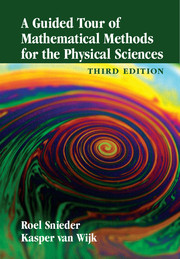Book contents
- Frontmatter
- Contents
- List of figures
- List of tables
- About the authors
- 1 Introduction
- 2 Dimensional analysis
- 3 Power series
- 4 Spherical and cylindrical coordinates
- 5 Gradient
- 6 Divergence of a vector field
- 7 Curl of a vector field
- 8 Theorem of Gauss
- 9 Theorem of Stokes
- 10 The Laplacian
- 11 Scale analysis
- 12 Linear algebra
- 13 Dirac delta function
- 14 Fourier analysis
- 15 Analytic functions
- 16 Complex integration
- 17 Green's functions: principles
- 18 Green's functions: examples
- 19 Normal modes
- 20 Potential field theory
- 21 Probability and statistics
- 22 Inverse problems
- 23 Perturbation theory
- 24 Asymptotic evaluation of integrals
- 25 Conservation laws
- 26 Cartesian tensors
- 27 Variational calculus
- 28 Epilogue, on power and knowledge
- References
- Index
28 - Epilogue, on power and knowledge
Published online by Cambridge University Press: 05 March 2015
- Frontmatter
- Contents
- List of figures
- List of tables
- About the authors
- 1 Introduction
- 2 Dimensional analysis
- 3 Power series
- 4 Spherical and cylindrical coordinates
- 5 Gradient
- 6 Divergence of a vector field
- 7 Curl of a vector field
- 8 Theorem of Gauss
- 9 Theorem of Stokes
- 10 The Laplacian
- 11 Scale analysis
- 12 Linear algebra
- 13 Dirac delta function
- 14 Fourier analysis
- 15 Analytic functions
- 16 Complex integration
- 17 Green's functions: principles
- 18 Green's functions: examples
- 19 Normal modes
- 20 Potential field theory
- 21 Probability and statistics
- 22 Inverse problems
- 23 Perturbation theory
- 24 Asymptotic evaluation of integrals
- 25 Conservation laws
- 26 Cartesian tensors
- 27 Variational calculus
- 28 Epilogue, on power and knowledge
- References
- Index
Summary
We all continue to feel a frustration because of our inability to foresee the soul's ultimate fate. Although we do not speak about it, we all know that the objectives of our science are, from a general point of view, much more modest than the objectives of, say, the Greek sciences were; that our science is more successful in giving us power than in giving us knowledge of truly human interest.
(Wigner, 1972)In this book we have explored many methods of mathematics as used in the physical sciences. Mathematics plays a central role in the physical sciences because it is the only language we have for expressing quantitative relations in the world around us. In fact, mathematics not only allows us to express phenomena in a quantitative way, it also has a remarkable predictive power in the sense that it allows us to deduce the consequences of natural laws in terms of measurable quantities. In fact, we do not quite understand why mathematics gives such an accurate description of the world around us (Wigner, 1960).
It is truly stunning how accurate some of the predictions in (mathematical) physics have been. The orbits of the planetary bodies can now be computed with extreme accuracy. Stephenson and Morrison (1995) compared the path of a solar eclipse at 181 BC with historic descriptions made in a city in eastern China that was located in the path of the solar eclipse. According to the computations, the path of the solar eclipse passed 50 degrees west of the site of this historic observation. This eclipse took place about 2000 years ago; this means that the Earth has rotated through about 2.8 × 108 degrees since the eclipse. The relative error in the path of the eclipse over the Earth is thus only 1.7 × 10−7. In fact, this discrepancy of 50 degrees can be explained by the observed deceleration of the Earth due to the braking effect of the Earth's tides.
- Type
- Chapter
- Information
- A Guided Tour of Mathematical Methods for the Physical Sciences , pp. 545 - 546Publisher: Cambridge University PressPrint publication year: 2015



